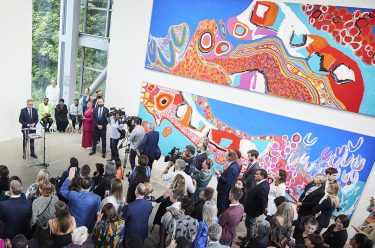The fascinating career of the late Bentinck Island artist and senior Kaiadilt woman Mirdidingkingathi Juwarnda Sally Gabori (c.1924–2015) is explored in a retrospective exhibition at the Gallery. ‘Dulka Warngiid – Land of All’ reveals Gabori’s instinct for vibrant colour, bold forms and gestural brushstrokes, and her deep connection to Country and her home, Bentinck Island.
Taking its title from the Kayardild language name for Bentinck Island, which translates as “the whole world”, “the land of all” or “the one place”, the retrospective reflects on the many stories of Gabori’s place and the body of work she created since commencing painting in 2005 at the age of 81. Among more than 50 works are her first and last paintings, large-scale collaborative works produced alongside other senior Kaiadilt women, and works on paper created toward the end of her career.
This exhibition celebrates Gabori’s life and work, and strengthens QAGOMA’s commitment to visibly acknowledging Queensland’s Indigenous artists. ‘Dulka Warngiid – Land of All’, includes much loved works from QAGOMA’s collection, as well as works drawn from private and public collections.
DELVE DEEPER: The life and art of Sally Gabori


The exhibition features four major works by Gabori in the Gallery’s Collection, including a pivotal early work (Dibirdibi Country – Topway 2006), one of her acclaimed monumental six-metre canvases (Dibirdibi Country 2008), a major six-metre collaborative work painted alongside her sisters and nieces (Makarrki – King Alfred’s Country 2008) and one of her late-career master works, the four-panelled Dibirdibi Country 2012. The thematic groupings of works trace Sally’s stylistic shifts over her short but dynamic career, with each one highlighting her relationship to the places on Kaiadilt Country she was tied to. Gabori painted five key places hundreds of times each, every painting different from the one before, sometimes markedly – yet in each work there are landscape cues to be found. There are paintings highlighting the artist’s Country at Mirdidingki; her father’s Country at Thundi; her grandfather’s Country at Dingkari; Nyinyilki, the main outstation on Bentinck; and Dibirdibi Country, the places associated with her husband Pat.

Acknowledgment of Country
The Queensland Art Gallery | Gallery of Modern Art acknowledges the Traditional Owners of the land on which the Gallery stands in Brisbane. We pay respect to Aboriginal and Torres Strait Islander Elders past and present and, in the spirit of reconciliation, acknowledge the immense creative contribution First Australians make to the art and culture of this country.
It is customary in many Indigenous communities not to mention the name or reproduce photographs of the deceased. All such mentions and photographs on the QAGOMA Blog are with permission, however, care and discretion should be exercised.
#QAGOMA

